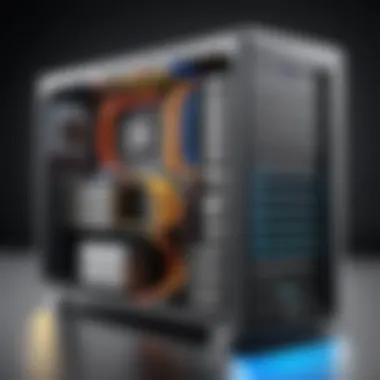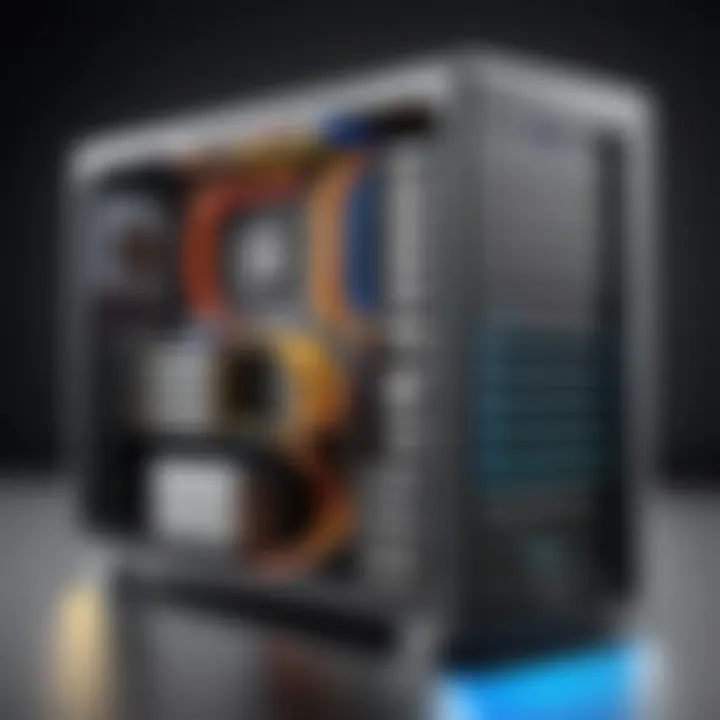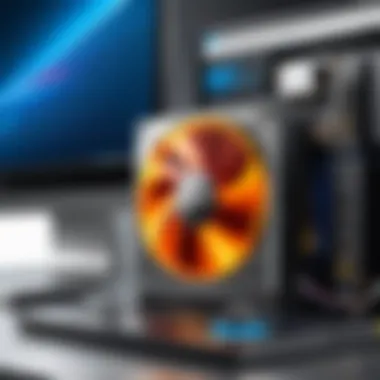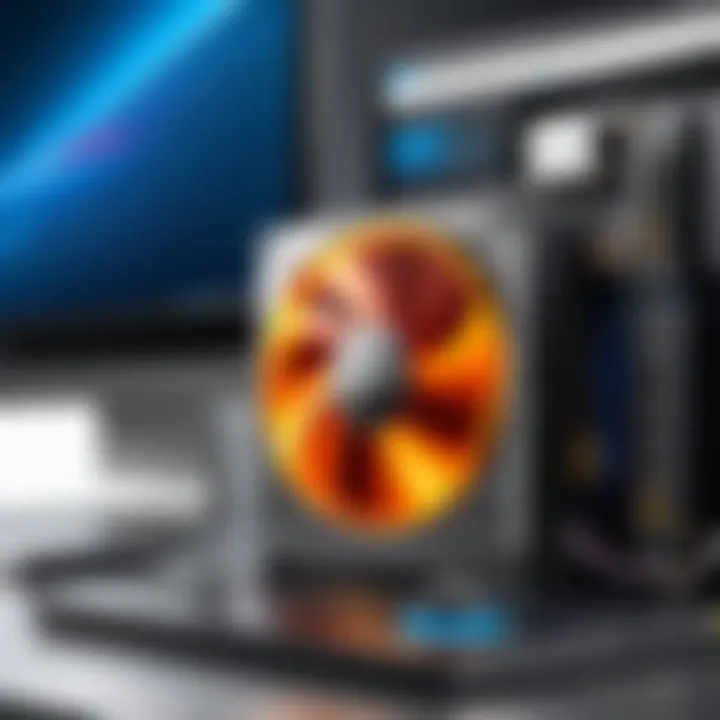Maximize Your PC Storage: Effective Management Strategies


Intro
When you're using a personal computer, running out of space can feel like running out of breath. Your machine slows down, applications lag, and the once smooth experience becomes a bumpy ride. Every file, from that half-finished school project to the latest blockbuster game, takes up space. We often underestimate the importance of storage management until it becomes a persistent annoyance.
By optimizing your storage, you enhance your PC's performance and extend its lifespan. Let’s dive into various techniques and strategies for freeing up that precious space. This is more than just deleting files; it’s about understanding what you truly need versus what’s just taking up room.
Identifying Unnecessary Files
The Garbage Life of Storage
The first step in managing your storage effectively is knowing what’s cluttering it up. Consider the following:
- Duplicate Files: These notorious space-stealers often hide in plain sight. Use file management software to scan your system for duplicates.
- Old Downloads: Regularly, we download files for a specific reason — only to completely forget about them. A good cleanup of your Downloads folder can free up quite a bit of space.
- Unused Applications: Programs you’ve forgotten about can take up valuable resources. Uninstalling those is often an instant win.
Techniques for Discovery
To highlight unnecessary files, you might want to use built-in tools like Disk Cleanup on Windows or Storage Management on macOS. Both tools provide detailed views of how your storage is used. For example, did you know that temp files can pile up quickly? You might be surprised how tossing out those unwanted files can immediately enhance performance.
Utilizing Built-in Tools and Software Solutions
Operating System Tools
Your operating system likely comes with tools designed specifically for this purpose:
- Windows Storage Sense: Automatically removes files that are no longer needed.
- macOS Optimized Storage: Suggests files to delete or move to iCloud and provides storage recommendations.
Third-party Software
While the built-in tools can do the job, sometimes it’s wise to call in heavy artillery:
- CCleaner: This program cleans up junk files and helps manage startup items.
- TreeSize: This gives a visual representation of what folders are taking up the most space.
Getting a handle on your storage is vital. A methodical approach to organization often pays massive dividends in the long run.
Regular Maintenance Practices
Clean as You Go
To stay ahead of the clutter, consider implementing regular housekeeping habits. Just like doing the dishes, a few minutes spent on file management can keep the chaos at bay. Schedule monthly cleanups to go through your files, whether it means sorting through documents or organizing your desktop.
Backing Up Your Data
Backups are essential. Storing files on external drives or utilizing cloud services like Google Drive or Dropbox not only frees up local space but also protects against data loss. Just remember to sort through the massive amounts of files backed up; otherwise, you might just move clutter from one location to another!
"Storage management isn’t just about clearing space; it’s about optimizing your digital environment for efficiency and ease."
As we build awareness around file management practices and maintain optimal storage, let’s explore more methods to enhance your PC’s performance in the sections to come.
Understanding Storage Limitations
When it comes to maximizing the efficiency and longevity of a personal computer, grasping the concept of storage limitations is paramount. Storage isn’t merely a container for files; it’s the backbone of a computer’s performance. Each byte of data has a role, and understanding how these limitations play out is critical for anyone looking to optimize their setup. Without this knowledge, one might run into issues that cause sluggish operation, crashes, or even data loss.
Types of Storage on a PC
Diving into the types of storage available, it’s vital to understand that not all storage is created equal. The prevalent kinds include:
- Hard Disk Drives (HDDs): These traditional drives offer large capacities at a low cost. They’re perfect for bulk storage but can be slow when loading programs or files.
- Solid State Drives (SSDs): SSDs are the modern game-changer, delivering significantly faster read and write speeds. While they come at a premium price for less capacity, their speed makes them an ideal choice for operating systems and frequently used programs.
- Hybrid Drives (SSHDs): These combine the elements of both HDDs and SSDs, aiming to provide the best of both worlds. While not as fast as SSDs, they offer enhanced performance compared to traditional HDDs.
- External Drives: Options like USB flash drives and external HDDs bring flexibility, allowing for additional storage without opening the case. Ideal for backing up critical files, they’re portable yet can be slower than internal drives.
Choosing the right storage depends on need. Gaming enthusiasts often prefer SSDs due to their speed, while casual users might opt for larger HDDs for the price.
Identifying Storage Bottlenecks
Knowing what’s bogging down your PC is like hunting for a needle in a haystack, yet it’s crucial for enhance performance.
Some common signs of storage bottlenecks include:


- Slow Startups: If your Windows tends to hang on the booting screen, your drive might be struggling.
- Lag During File Transfers: A noticeable delay when moving files can indicate an issue.
- Programs Taking Ages to Load: Programs should open promptly. If they don’t, it’s time to investigate.
To dig deeper, you can utilize tools like Task Manager or Resource Monitor to get a clear view of disk performance. Look for high disk usage and identify which applications are the culprits. When these issues arise, it’s usually a clear signal that either the drive is nearing its capacity or it’s experiencing hardware degradation. Addressing these bottlenecks involves precise diagnostics and potentially upgrading to a faster or larger storage solution.
"Understanding the strengths and weaknesses of your PC's storage types can unlock the true potential of your machine."
Ultimately, knowledge of storage limitations ultimately leads to a better-functioning PC. This section serves as a foundation for the strategies to be covered further in the article.
Assessing Current Disk Usage
Understanding disk usage is crucial for anyone looking to optimize their computer's space. Assessing how much storage is actually being consumed allows users to make informed decisions on what to keep and what can be tossed into the digital trash. Regular checks on disk usage can prevent sudden surprises, like running out of space during an important operation, which can lead to chaos—especially for gamers and tech enthusiasts who heavily rely on their PCs.
Benefits of assessing your disk usage are manifold. First off, you gain visibility into how your storage is distributed across files, applications, and system tools. This understanding helps pinpoint culprits—you know, the applications that take up far more space than they should. Additionally, monitoring your disk usage allows for efficient management of installed programs; software that hasn’t seen the light of day for ages can take a backseat or be uninstalled altogether.
With this in mind, let’s dive into two approaches to assessing disk usage: built-in disk space analyzers and third-party tools.
Using Built-in Disk Space Analyzer
Most operating systems come with built-in tools specifically designed to map out disk usage. For Windows users, the Disk Cleanup utility is a classic option that provides a summary of what’s hogging space. You can access it by searching "Disk Cleanup" in your start menu. Once you launch it, you can see categories like Temporary files, System Files, and Recycle Bin.
This tool not only helps identify space-wasting files but also assists in clearing them out efficiently. With just a few clicks, you can free up a significant chunk of storage. Remember, it’s more than just clearing cache; you might find old Windows update files taking up an extraordinary amount of space. This is common in many setups where system updates are neglected.
Some might also turn to the built-in Disk Usage tool on Mac. Found under the Apple menu, the "About This Mac" section features a storage tab that sorts files into categories. Here, you can visually see the space each category consumes using colorful bars—very intuitive!
Third-party Disk Usage Tools
For those who need a more robust analysis, third-party disk usage tools can be game-changers. Programs like WinDirStat for Windows or DaisyDisk for Mac provide a visual representation of your disk anatomy.
Using these tools can feel like peeling back layers of an onion—in a good way. For instance, WinDirStat shows you a colorful treemap where each block represents a file. It becomes patently obvious which files are the storage-hogs, allowing you to take action swiftly.
Here are some commonly used third-party tools:
- WinDirStat: Offers a deep dive in a user-friendly interface.
- DaisyDisk: Boasts beautiful visuals and quick analysis for Mac users.
- SpaceSniffer: This tool’s portable version lets you analyze disk space without installation, a nifty feature for those wary of additional software.
Using third-party tools also allows for sorting by file type or size, making it easy to find duplicates or those very large files you might want to back up elsewhere.
"Knowing what resides on your hard drive isn’t just about freeing space; it reflects how you use your digital resources and helps you channel your productivity effectively."
Combining both built-in and third-party analysis can be the double whammy you need to maintain an optimal PC without the hassle of space-related chaos.
Removing Unnecessary Files
In the digital age, where every byte of memory counts, understanding the significance of removing unnecessary files can’t be overstated. Our devices collect a plethora of files over time, many of which serve no real purpose, just taking up valuable storage space. Removing these files not only clears out the clutter but also optimizes your device performance, ensuring smoother operation.
One might wonder why they should bother with this task. The benefits are manifold. For one, decluttering your storage can enhance speed. Devices bogged down with unnecessary files tend to lag, making even the simplest tasks feel like trying to wade through molasses. Moreover, by trimming the fat, you reduce the risk of files becoming corrupted or fragmented, which can lead to crashes or loss of data.
Temporary Files and Cache Management
Every time you run a program or browse the internet, temporary files and cache get created. These files serve short-term purposes like speeding up access to frequently used data. However, over time, they can accumulate like dust in the corners of a room.
Why should you care? Temporary files can consume a significant amount of disk space without you even realizing it. By regularly managing these files, you free up space and potentially increase the overall performance of your PC. Tools like Disk Cleanup in Windows or storage management features in macOS can help automate the process. To do this manually:
- For Windows: Navigate to and follow the prompts.
- For Mac: Go to .
Unused Applications and Their Impact
Unused applications might just seem like unoccupied shelves in a storage unit, but they bring more clutter than you might think. Each application takes up disk space and consumes valuable resources when they update or run background processes.
Consider this: you may have downloaded a game or a tool that you haven’t touched in months. This not only utilizes storage but may also slow your system down during boot-up. Uninstalling programs you no longer require is an effective way to reclaim that valuable space.
- Common signs you have bloatware include:
- Programs that automatically run at startup.
- Applications that you have not opened in the past 3-6 months.
To get rid of these applications, you can venture into for Windows or go to for macOS.
Old Downloads and Their Clutter


Ah, the Downloads folder—it's like a purgatory for files. It’s so easy to let things pile up without a second thought. Screenshots, PDFs, and files downloaded for one-off purposes sit there long after they’ve served their time. It's not uncommon to find old installers or school assignments that no longer hold relevance.
If you don't tidy up this space, it can quickly become a labyrinth. Not only does it confuse you about what’s actually important, but it can also lead to surprises—like running out of space when you actually need it. Regularly sifting through and deleting files that are no longer needed can significantly free up disk space.
Tip: Set a reminder every month to go through your Downloads folder. Not much but a quick, monthly clean-up can make a world of difference.
File Organization Techniques
File organization might sound like a mundane task, but it plays a vital role in maximizing your PC's storage efficiency. A coherent file organization system can help you locate files swiftly, keep your workspace tidy, and significantly reduce the clutter on your drives. More than just aesthetics, how you organize your folders can directly impact your computer’s performance and your workflow. Additionally, implementing better organization habits can save you from the frustration of searching through endless folders and subfolders.
Creating a Logical Folder Structure
The first step in this endeavor is to devise a logical folder structure. Think of your computer like a library. Each shelf represents a different subject area, and within those areas, you have stacks of related books. Here’s how to create a folder system that would make any librarian proud:
- Start Broad, Then Narrow Down: Begin with broad categories that capture the essence of your files, like "Work", "Personal", "Games", or "Media". Within each main folder, further delineate subfolders that specify the content. For example, under "Media", you could have "Photos", "Videos", or "Music".
- Use Descriptive Names: Be clear and descriptive with folder names. Instead of nicknaming a folder "Stuff", name it "2023 Projects" or "Summer Vacation Photos". This makes it easier to remember what's inside.
- Consider Dates or Versioning: For documents that might get reworked, add dates or version numbers to the folder names. Something like "Project_Plan_v1_Apr2023" gives context at a glance.
- Avoid Over-categorization: While it’s essential to be specific, having too many subfolders can paradoxically lead to confusion. Keep it simple – just enough to make files easily accessible.
- Regular Maintenance: Set a reminder to review folders at least once a quarter. Why? Because files and needs change, so your organization should too. More often than not, you’ll find old projects worth deleting or archiving.
Creating a logical folder structure not only streamlines your storage but also enhances your efficiency by reducing the time spent searching for files.
Utilizing Cloud Storage Solutions
In this modern age, cloud storage represents an extension of physical space, allowing you to store files remotely. This can be particularly useful for gamers, tech enthusiasts, and professionals alike. Here’s how cloud storage can revolutionize your file organization:
- Accessibility from Anywhere: With cloud storage, files can be accessed from any device that connects to the internet, which is great when you're on the go or playing on different platforms.
- Automatic Backup: Many cloud solutions offer automatic backup features. If you’re prone to forgetting to back up data, this is your safety net. You'll always have your important gaming saves and work documents available even in the event of a hardware failure.
- Flexible Storage Options: Providers like Google Drive, Dropbox, and OneDrive offer various storage sizes, ensuring that you can scale up or down based on your needs. This flexibility can help you avoid reaching your PC’s storage limits.
- Collaboration Made Easy: For esports teams or projects requiring joint effort, cloud storage allows multiple users to access and edit documents simultaneously. This is particularly useful when strategizing for lans or tournaments, as everyone can stay updated in real-time.
- Cost-Efficient: Depending on your needs, utilizing free versions or affordable subscriptions of cloud services can save you money in the long run.
"Organizing files is not just about saving space; it’s about enhancing productivity and ensuring ease of access."
Explore more about folder organization here and investigate cloud solutions on Reddit.
Leveraging Built-in Optimization Tools
Optimizing storage on a personal computer is not just about removing files. It requires understanding how to use the tools already embedded in the system. Built-in optimization tools can unleash the latent potential of your PC, allowing it to run smoothly and effeciently. They help to simplify and accelerate the process of maintaining storage, reducing the heavy lifting you may think necessitates manual intervention.
These tools serve multiple purposes: from disposing of unwanted data, to improving system performance. Ignoring them could mean missing out on a straightforward solution that could significantly enhance your user experience. As gamers or tech enthusiasts, you know how crucial every second counts; having your computer boot up faster or load games more efficiently makes a noticeable difference.
Incorporating these built-in tools into your regular routine might just save you from future headaches. They are designed specifically for your operating system, which means they're tailored to work seamlessly with your hardware.
"Regular maintenance using built-in tools can extend the lifespan of your PC and provide better performance for your activities."
Disk Cleanup Utility Overview
The Disk Cleanup Utility takes the crown when it comes to freeing up space on your PC. Think of it as a digital spring cleaning. This tool scours your hard drive for files that are no longer needed. Temporary files, system files, and even cache are its prime targets. By selecting the files you want to delete, you're like a curator, deciding what stays and what goes.
To access it, simply search for "Disk Cleanup" in your start menu. Once the utility is opened, it will present you a list of files that can be safely removed. Not sure what to pick? Here are some common culprits:
- Temporary Internet Files: These files accumulate every time you browse the web. Deleting them can significantly free up space.
- System Error Memory Dump Files: Not as useful as they may sound; they mainly serve debugging purposes.
- Recycle Bin: Old trash can get heavy, toss it out!
When making your selections, a good rule of thumb is: if you haven't used it in a while, it's probably safe to delete. Remember to confirm your choices; you don’t want to accidentally wipe out something essential!
Defragmentation and Its Benefits
Defragmentation is akin to rearranging your closet. Over time, files can become scattered across the hard drive like clothes thrown all over the floor. This scatter makes it harder for your system to locate files quickly. That's exactly where defragmentation comes into play.
By aligning the fragmented files, your operating system can access them quicker, resulting in better performance. Access times improve, meaning that programs don’t take ages to launch, and files open at the click of a button. A well-organized drive is not just nice to look at; it’s efficient too.
Here’s why you should consider implementing a defragmentation routine:
- Speed Boost: Faster access to files translates into improved overall system performance.
- Increased Lifespan of Hardware: A more efficient drive may reduce wear and tear, indirectly prolonging the life of your hard drive.
- Enhanced Stability: Systems tend to run more smoothly when their data is in order.
Most modern operating systems automatically defrag your hard drive, but it’s worth checking if that feature is enabled. If you’re using an SSD, however, you may not need to do this. Solid-State Drives use a different method of storing data, so defragmentation doesn’t improve performance in that case.
By incorporating built-in optimization tools into your PC maintenance regime, you can keep your machine running like a well-oiled machine, giving you more room for games, software, or anything else your heart desires.
Remember, a little routine can prevent a lot of future headaches. You'll not only enhance the performance but also appreciate the smoother flow of your digital life.
Effective Data Backup Strategies
Backing up your data effectively is about more than just creating a copy of files; it’s about ensuring the safety and longevity of your digital life. For tech enthusiasts, gamers, and anyone juggling heaps of information, the stakes couldn't be higher. Lost game saves, corrupted files, or accidental deletions can ruin hours of effort. Implementing solid backup strategies offers peace of mind and can prevent a host of headaches down the line.


The landscape of data storage has transformed significantly over the years. Understanding why and how to back up data could mean the difference between living in panic mode or sailing smoothly through life with a well-maintained digital setup.
Options for Data Backup
When it comes to backing up data, users have multiple options to choose from. Each method has its own set of pros and cons, and selecting the right one depends heavily on personal needs, storage requirements, and available resources.
- Cloud Storage: Services like Google Drive, Dropbox, and OneDrive offer the convenience of accessible backups from anywhere, provided you have internet access. This method is favored by many, especially for its ease of use and sharing capabilities.
- External Hard Drives: A tangible solution for backups, external hard drives provide a reliable way to store large quantities of data offline. They often come with backup software, allowing for automated backups of essential files, which can be set easily.
- Network Attached Storage (NAS): For the serious techie, NAS devices serve as a central hub. Storing data on a network means multiple users can access this storage from different devices, making NAS perfect for homes with multiple PCs.
- Local Backups: Simply copying files to another partition or another computer can be a straightforward way to protect files. Though this is accessible, it does lack the protection against fires or floods that other methods offer.
"The right backup solution not only saves data but also time and hassle when things go sideways."
Best Practices for Secure Backups
After settling on a preferred backup method, it’s crucial to implement best practices that ensure data security. Here's a compilation of essential guidelines:
- Regularly Update Backups: It’s all too easy to set a backup process and then forget about it. Schedule regular intervals—whether it’s weekly or monthly—to make sure backups are up-to-date.
- Verify Backup Integrity: Sometimes, files don’t copy over correctly. Occasionally check the backed-up files manually to make sure everything is as it should be. This step helps assure that you can access the essential data when you need it.
- Use Encryption: Given the rise of cyber threats, encrypting sensitive data adds another layer of protection. Services like VeraCrypt can help with that for local files, while many cloud services also offer built-in encryption.
- Test Restore Procedures: Having backups is great, but if you don’t know how to restore files, you might find yourself in a sticky situation. Familiarize yourself with the restore process of your chosen method, practicing if necessary.
- Diversify Backup Locations: Don’t put all your eggs in one basket. Store backups in multiple locations: one on a cloud service and one on a physical drive, for example. This way, if one fails, you’ve got a backup for the backup.
Advanced Techniques for Space Management
In the world of personal computing, optimizing storage isn't just a matter of tidying up. It's about carving out an efficient way to manage the digital debris that accumulates over time. Advanced techniques for space management offer users powerful strategies to ensure that their systems run smoothly and efficiently. These methods are not merely options but essential practices for anyone keen on unlocking their PC's full performance potential. With the rapid advancement of applications and data-heavy programs, understanding how to streamline your storage can prevent a major headache down the line.
Partitioning Your Hard Drive
Partitioning your hard drive can feel a bit like dividing a room into smaller, more manageable sections. By creating separate partitions, you're not only organizing your files but also optimizing system performance. Imagine each partition as a distinct zone for different types of data: one for the operating system, another for applications, and perhaps a third for gaming. This separation helps in several ways:
- Improved Performance: When files are arranged logically, the system accesses them faster. This can lead to quicker boot times and even enhance game load speeds.
- Increased Security: If one partition encounters an issue, such as corruption or a virus, the others can remain unaffected, safeguarding your important data.
- Simplified Backups: You can back up specific partitions based on their importance or sensitivity, streamlining the backup process.
However, it’s important to tread carefully. Missteps during partitioning can lead to data loss, so having a reliable backup before beginning the process is vital.
Exploring External Storage Solutions
Sometimes, despite our best efforts, internal storage just doesn't cut it anymore. This is where external storage solutions come into play. Think of external storage as a supplementary space where you can stash all those hefty files without cluttering your primary drive. Here are a few popular options:
- External Hard Drives: These devices offer large storage capacities and are excellent for backing up entire systems without breaking the bank. They can easily be taken anywhere.
- USB Flash Drives: While smaller, they’re handy for quick file transfers or keeping essential documents at your fingertips.
- Network Attached Storage (NAS): This setup connects to your network, allowing multiple devices to access data seamlessly. It’s like having your own cloud service right at home.
When considering external storage, think about what you need. Fast access times? Go for an SSD. Long-term backup? A traditional hard drive might serve you better. Ultimately, external solutions not only expand your storage capabilities but also introduce an extra layer of flexibility.
"In the digital age, managing your space effectively can be the difference between smooth sailing and a cluttered storm."
With these advanced techniques, you can no longer feel overwhelmed by the digital clutter. You take control, ensure smooth operation, and give your PC a fighting chance against the perennial battle of storage limitations.
Maintaining Optimal Performance
Maintaining optimal performance on your personal computer is crucial for ensuring a seamless user experience, particularly for those who rely heavily on their PC for gaming, content creation, or intensive multitasking. A system that runs smoothly not only enhances productivity but also prolongs the lifespan of the hardware. In this section, we will delve into two central aspects: monitoring disk health regularly and setting up routine maintenance checks. These practices contribute significantly to optimizing storage and maintaining overall system functionality.
Monitoring Disk Health Regularly
Keeping an eye on the health of your disk is vital. A hard drive that’s on its last legs can lead to a range of problems, from slower performance to total data loss. Regular monitoring can help catch issues before they spiral into bigger headaches. Here are a few key points to consider:
- Using Built-in Tools: Windows and macOS come equipped with disk checking utilities. For instance, you can utilize the Command Prompt in Windows to run the command, which can diagnose and repair disk errors automatically. In macOS, the Disk Utility helps fix issues and monitor the status of the disk.
- Third-party Software: For those who crave a bit more insight, third-party applications like CrystalDiskInfo or HD Tune can provide detailed health reports of your drives. These tools inspect various parameters, including temperature, read/write errors, and overall drive performance.
- Regular Backups: As you monitor disk health, don't forget the golden rule: always have backups! Keeping your data secure ensures you won’t face tragic losses even if a hard drive fails unexpectedly.
"An ounce of prevention is worth a pound of cure." - Benjamin Franklin
Setting Up Routine Maintenance Checks
Just like routine check-ups are essential for your health, regular maintenance checks are vital for your computer’s performance. This proactive approach can not only enhance speed but also keep your system running smooth as butter. Here’s how to set it up:
- Schedule Disk Clean-up: Utilizing the Windows Disk Cleanup tool or macOS’s built-in optimization features regularly can clear out unnecessary files. You could set reminders every month to tackle this task.
- Run Disk Defragmentation: If you’re using an HDD, consider running a defragmentation tool. Though SSDs don’t require this due to their architecture, defragging can help a fragmented HDD regain its speed.
- Check for System Updates: Make it a habit to check for software and system updates. Sometimes performance lags occur due to outdated software or drivers.
- Monitor System Performance: Keep an eye on task managers or performance monitors that show CPU, memory, and disk usage. Identifying resource hogs can provide insight into what’s slowing down your machine.
Ending: The Importance of Regular Space Management
Maintaining ample storage space on your PC is not just a matter of convenience; it is fundamental for ensuring seamless performance and optimal functionality. Regular space management can significantly affect how well your system operates, particularly for those who rely on their computers for demanding tasks such as gaming or graphic design.
Being proactive in managing your computer’s storage can lead to a host of benefits:
- Enhanced Performance: Fragmented drives or those filled to the brim can lead to slow load times and hindered performance. By regularly decluttering your storage, you allow your system to operate more efficiently. This is particularly crucial for applications that require quick access to large files.
- Increased Lifespan: A well-maintained PC does not just run better; it lasts longer. Excess clutter can tax hardware components, leading to overheating or premature wear. Regular maintenance helps mitigate these risks.
- Better Backup Management: When you keep your storage organized, it becomes much easier to manage backups. This can be vital for ensuring that critical files and data are always secure, reducing potential losses and mishaps.
- Simplified Upgrading: If you ever decide to upgrade your storage, having a clear grasp of what you have can facilitate the process. If you know what files are essential and which ones have outlived their usefulness, transitioning to a more extensive storage solution is a breeze.
To sum it up: taking the time to manage your storage regularly is equated with being a savvy tech user. It’s not about making changes weekly or monthly, but rather developing a mindset where you’re continually aware of your disk usage.
"The road to your PC's optimal performance is paved with regular maintenance."
Even employing simple techniques—like cleaning up unnecessary files, organizing folders, and utilizing built-in optimization tools—can go a long way in sustaining a healthy storage environment. The balance between performance and longevity lies in consistent attention to detail when it comes to managing space on your machine.
Ultimately, for esports enthusiasts, technology aficionados, and gaming fanatics, integrating regular space management into your routine can not only improve your current performance but also set the stage for future upgrades and advancements as your needs evolve. Keeping an eye on space prevents headaches down the road and contributes to a more enjoyable user experience.



